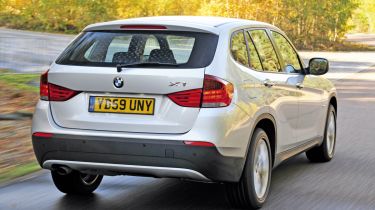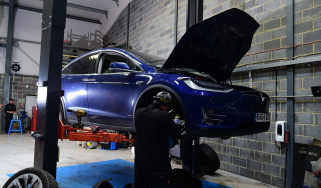BMW X1
Brand aims to make a big splash in the lucrative compact SUV market
Most SUV owners don’t really need four-wheel drive, so it comes as no surprise that BMW is offering its new X1 with power sent to two or all four corners of the car.
But while our 2WD Kuga’s front wheels are driven, in its lesser form the BMW’s rear tyres do all the work. And, compared with its opponents here, the German model sits much lower.
Video: watch CarBuyer's video review of the BMW X1
[[{"type":"media","view_mode":"content_narrow","fid":"68468","attributes":{"alt":"","class":"media-image"}}]]
In fact, it looks more like a high-riding estate car than a true compact SUV. Only the squared-off wheelarches, 4x4-style exterior cladding and chunky bumpers hint at the BMW’s target market. From the front, the X1 appears imposing thanks to a thrusting chin, trademark grille and swept-back headlights, but it’s far from attractive overall.
Things don’t improve in profile or from the rear – these are even less flattering views of the striking design. Four-wheel-drive versions benefit from contrasting silver trim and roof rails.
Initially, the interior seems to maintain BMW’s usual high standard of fit and finish. But on closer examination, there are a few flaws, and the X1 doesn’t match the quality of other cars in the range.
The shiny and hard plastics used for the lower part of the centre console are particularly disappointing, although existing BMW owners will be familiar with the smart switchgear.
It’s easy to get comfortable, however. There’s a wide range of adjustment for the supportive seat and chunky steering wheel, so drivers of all shapes and sizes should be able to find a perfect position.
Yet that only serves to highlight other ergonomic failures in the design. For example, the switches that operate the electric windows are awkwardly positioned too far back along the door.
Rear legroom is tight compared with that offered by rivals here. Our tape measure revealed passengers travelling in the back of the Ford benefit from 80mm more leg space. And the BMW’s rear doors are small, which doesn’t make access easy, especially when dealing with children.
There’s nothing wrong with the boot capacity, though. When the back seats are in place, there’s a 420-litre load area – placing the BMW in the middle of this trio. Where the X1 really comes into its own is on the road. Its communicative steering helps to make it the most rewarding car to drive.
However, the effort required to turn the wheel can become tiresome around town, as can the heavy clutch. On the open road, the firm damping keeps body roll in check through corners, but the trade-off is a hard ride over all but the smoothest surfaces.
The star of the show is BMW’s 177bhp 2.0-litre engine. It’s a willing unit that delivers lively performance.
Against the clock, the X1 sprinted from 0-60mph in less than nine seconds. Tall ratios blunt in-gear responses, although CO2 emissions of 139g/km help compensate for this.
Equally impressive was the car’s economy. In our hands, it returned 40.1mpg – no doubt aided by the EfficientDynamics hardware, which includes a smooth stop-start system.
Potential buyers will have to weigh this up against the purchase price – as the X1 doesn’t come cheap. Even our more affordable two-wheel-drive sDrive variant is a shade over £24,200, and it has a high insurance group rating of 25. As a result, a year’s cover will cost nearly £400 more than its rivals here.
So while the X1 is a rewarding car to drive and carries a prestige badge, it doesn’t make the kind of impact we’ve come to expect from new BMWs. The high price, uninspiring looks and cramped interior could count against it.
Details
Chart position: 3
WHY: X1 brings tough looks, a sharp chassis and desirable image to compact SUV sector.







